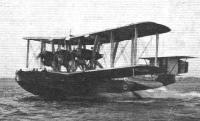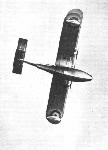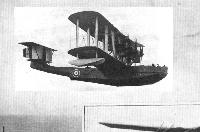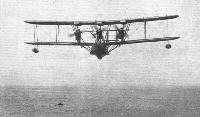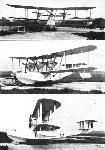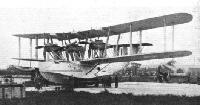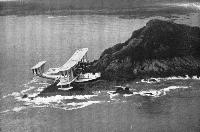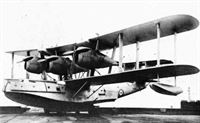
Описание
Страна : Великобритания
Год : 1926
Летающая лодка
Летающая лодка - разведчик с экипажем из пяти человек
Варианты
- Blackburn - Iris / R.B.1 - 1926 - Великобритания
- Blackburn - Perth / R.B.3 - 1933 - Великобритания
Blackburn RB.1 Iris
Первый опыт постройки больших летающих лодок фирма "Blackburn" получила после выхода спецификации R.14/24 Министерства авиации, предназначенный для ведения дальней морской разведки. В результате был спроектирован самолет Blackburn RB.1 Iris - первый в ряду RB (Reconnaissance Boat - разведывательная лодка), согласно новой системе обозначений фирмы. Это был трехдвигательный биплан деревянной конструкции с экипажем из пяти человек. Впервые взлетевшая 19 июня 1926 года, большая летающая лодка этим же летом прошла испытания в MAEE (Marine Aircraft Experimental Establishment - организация по испытаниям морских самолетов). Но фирма "Blackburn" уже решила строить новый металлический корпус, и в следующем году Iris вернули на завод для проведения доработок. Вместо моторов Rolls-Royce Condor III мощностью 650 л.с (485 кВт) на самолет установили Condor IIIA мощностью по 675 л.с. (503 кВт), присвоив доработанной машине обозначение RB.1A Iris II.
После испытаний RAF машина Iris II совершила демонстрационные полеты по Средиземноморью, Ближнему Востоку, Индии и Скандинавии. В результате, под впечатлением этого показа Министерство авиации заказало три RB.1В Iris III, первый из которых поднялся в воздух в ноябре 1929 года. Благодаря использованию в конструкции дюраля и другим доработкам, эта модификация превосходила свою предшественницу. Все три машины были переданы 209-й эскадрилье, прошедшей переформирование в Маунт Баттене, Плимут. Самые большие на тот момент самолеты RAF, летающие лодки Iris, совершили ряд зарубежных турне, но в феврале 1931 года одна из них была потеряна в катастрофе, и фирме был заказан самолет для замены.
RB.1С Iris IV представлял собой Iris II, оснащенный двигателями Armstrong Siddeley Leopard III мощностью по 800 л.с. (597 кВт), причем центральный мотор был толкающим, а крайние - тянущими. Масса пустого самолета была на 649 кг меньше, чем у предшественника, а скорость на уровне моря возросла до 209 км/ч.
Последней модификацией стал RB.1D Iris V. Эти самолеты не строились заново, а переделывались из Iris III путем установки на них новых моторов Rolls-Royce Buzzard IIMS мощностью по 825 л.с. (615 кВт). Первый доработанный самолет поднялся в воздух в марте 1932 года. Служба Iris V была недолгой - два самолета были потеряны в январе 1933 года. Третью машину вернули "Blackburn" для летных испытаний двигателей Junkers Jumo IVC мощностью 720 л. с. (537 кВт), которые в дальнейшем выпускались в Англии под обозначением Napier Culverin Series 1. Позднее самолет использовали для испытаний антикоррозионной краски.
ТАКТИКО-ТЕХНИЧЕСКИЕ ХАРАКТЕРИСТИКИ
Blackburn Iris III
Тип: летающая лодка - разведчик с экипажем из пяти человек
Силовая установка: три V-образных поршневых двигателя Rolls-Royce Condor IIIB мощностью по 675 л. с. (503 кВт)
Летные характеристики: максимальная скорость 190 км/ч на уровне моря; крейсерская скорость 156 км/ч на оптимальной высоте; скороподъемность у земли 153 м/мин; потолок 3230 м; дальность полета 1287 км
Масса: пустого 8640 кг; максимальная взлетная 13 376 кг
Размеры: размах крыла 29,57 м; длина 20,54 м; высота 7,77 м; площадь крыльев 207,07 м1
Вооружение: по одному 7,7-мм пулемету Lewis на турелях в носовой, верхней и хвостовой стрелковых установках; до 907 кг на держателях под крылом
Описание:
- Blackburn RB.1 Iris
- Flight, July 1928
THE BLACKBURN "IRIS II” - Flight, April 1932
The Blackburn "Iris V"
Фотографии
-
Мировая Авиация 56
Регистрационный номер: S1263 [5] Этот Iris Mk III в начале 1930-х годов входил в состав 209-й эскадрильи. В тот период эскадрилья базировалась в Маунт-Баттен.
-
Aeroplane Monthly 1989-07 / E.Chilton - The 1927 Baltic 'boat tour
Регистрационный номер: N185 [8] THE SERVICE SCANDINAVIAN CRUISE: The one of the four R.A.F. flying-boats which are taking part in a cruise round Scandinavia. The metal-hull Blackburn Iris II N185 (three Rolls-Royce "Condors");
This aircraft was the original Iris I prototype, and had been relaunched as the Iris II shortly before the Scandinavian flight. -
Flight 1927-12 / Flight
THE AIR MINISTER DEPARTS: Sir Samuel Hoare sets out from Felixstowe in the Blackburn "Iris II" (three Rolls-Royce "Condors") en route for Copenhagen, August 12. Generally similar to the "Iris I," this flying-boat has an all-metal hull. Note the exceptionally clean running.
-
Aeroplane Monthly 1989-07 / E.Chilton - The 1927 Baltic 'boat tour
The Iris departs Felixstowe on August 12 for Copenhagen with Sir Samuel Hoare aboard.
-
Air Pictorial 1956-12 / Photos by request
Регистрационный номер: N185 [8] BIRD OF PASSAGE to India in 1928 was this five-seat, medium-range Marine Reconnaissance (Specification R. 14/24) Blackburn Iris Mk. II (N185). Powered by three 650-h.p. Rolls-Royce Condor Srs. III liquid-cooled Vee engines, the Iris Mk. II possessed a maximum speed of 118 m.p.h. for an a.u.w. of 27,000 lb. Endurance, from 8 3/4 hours (normal) to 10 hours (maximum).
-
Flight 1929-11 / Flight
THE BLACKBURN "IRIS III": The latest model of this type, built to order of the Air Ministry by the Blackburn Aeroplane and Motor Co., Ltd., was successfully launched at Brough on November 21. The new "Iris," which is of all-metal construction, has three 700 h.p. Rolls-Royce "Condor" engines, and weighs a matter of some 13 tons. An unusual feature of this machine is the provision of a gunner's cockpit at the extreme rear of the hull, immediately behind the tail 'planes. Sqdn.-Ldr. Rea, accompanied by Mr. W. D. Marriott, Mr. McCallum (representing the Air Ministry) and Maj. J. T. Rennie, of Blackburn's, carried out the launching flights last week, after which the flying-boat proceeded to Felixstowe to undergo service trials.
-
Flight 1929-03 / Flight
The Blackburn "Iris" Reconnaissance Flying-Boat, three Rolls-Royce "Condor" engines.
-
Flight 1928-10 / Flight
SIR PHILIP SASSOON'S AIR TOUR: The Blackburn "Iris" flying-boat, fitted with three Rolls-Royce "Condor" engines, in which the Under-Secretary of State for Air, Sir Philip Sassoon, is carrying out a tour of the R.A.F. Stations at Malta, the Middle East, Iraq, and India.
-
Flight 1939-05 / Flight
The Fly-past: The Secretary of State for Air, Sir Samuel Hoare, Bart., with whom is Lady Maud Hoare and their son, watching the Blackburn "Iris" flying off Cromer last week.
The original wooden-hulled Iris I (R.-R. Condors) -
Flight 1929-03 / Flight
APPRECIATION: The Blackburn "Iris" flying-boat with Rolls Royce "Condor" engines. Arrangements have recently been completed for building the "Iris" in the United States. It is also believed that this machine is the type referred to by Sir Samuel Hoare in connection with a new flying-boat squadron.
-
Flight 1926-10 / Flight
Not a Vertical Bank: This photograph shows the Blackburn "Iris" from below as the machine is passing overhead, and gives an excellent idea of the shape of the planing bottom, steps, etc.
-
Flight 1929-05 / Flight
Регистрационный номер: N185 [8] REPRESENTATIVE TYPES OF BRITISH AIRCRAFT: 1. The Blackburn Iris II, with three Rolls-Royce "Condor" engines, is a service flying-boat.
-
Flight 1926-10 / Flight
Регистрационный номер: N185 [8] MORE THAN 2,000 H.P.: Two views of the Blackburn "Iris," with three Rolls-Royce "Condor" engines. This machine is of recent construction and may not, therefore, be described. Doubtless, however, keen observers will be able to appreciate from these photographs many of its special features. No dimensions may be given, but the size of the figures of members of the crew help to lend "scale" to the machine.
-
Flight 1926-10 / Flight
THE BLACKBURN "IRIS": For a three-engined flying boat of large size the frontal area is remarkably small, as this front view illustrates.
-
Flight 1929-05 / Flight
The Blackburn "Iris" metal flying-boat, three Rolls Royce "Condor" engines
-
Flight 1927-12 / Flight
Регистрационный номер: N185 [8] 12 августа 1927г.: четыре прототипа летающей лодки покинули Феликстав, взяв курс на порты Балтики, чтобы помочь британским ВВС принять решение, какой из типов самолетов поступит на вооружение. Это были Supermarine Southampton, Blackburn (фото), Short Singapore и Saunders-Roe Valkyrie.
TME SEAWORTHY FLYING-BOAT: These three photographs show the Blackburn "Iris II" with three Rolls-Royce "Condor" engines. The hull is of metal construction. Note the sharp concave Vee-bottom, and the exceptionally "clean" running on the water. -
Aeroplane Monthly 1989-07 / E.Chilton - The 1927 Baltic 'boat tour
Регистрационный номер: N185 [8] The metal-hulled Blackburn Iris II N185, powered by three Rolls-Royce Condors.
-
Flight 1930-01 / Flight
The return of the "Iris."
-
Aeroplane Monthly 1988-12 / Personal album. Military
Регистрационный номер: N185 [8] Blackburn Iris prototype N185 seen after modification to Iris II status, with metal hull, fitted with three Rolls-Royce Condor IIIA engines and with the centre rudder removed and replaced with a servo unit and moved further forward to occupy the original fin position. N185 was later converted to Mk IV standard and fitted with Armstrong Siddeley Leopard III radial engines.
-
Flight 1926-09 / Flight
2,000 H.P.: These three photographs show the Blackburn "Iris" three-engined flying boat with Rolls-Royce "Condor III" engines.
-
Flight 1930-11 / Flight
Blackburn Iris III flying-boat.
-
Flight 1930-02 / Flight
Регистрационный номер: N238 [3] The Blackburn "Iris III" Flying-Boat is of all-metal construction except for the wing covering.
-
Flight 1931-07 / Flight
Регистрационный номер: S1593 [4] LAUNCH OF A NEW BLACKBURN "IRIS": Yet another flying boat of the "Iris" type was launched at the Blackburn works at Brough, Yorks, recently. Like previous machines of this type it is fitted with Rolls-Royce "Condor" engines. Modifications have, however, been made to the lines ot the hull, notably in the bows. The lower picture gives a good idea of the biplane tail and gunner's position.
-
Aeroplane Monthly 1982-06 / G.Foden - Strange encounter
Регистрационный номер: N238 [3] N238 was the prototype Iris III. This photograph shows the flying boat ready for launching at Brough in October 1926.
-
Flight 1931-06 / Flight
An "Iris" (three 650 h.p. "Condors") of No. 209 (Flying Boat) Squadron cruising off the Devon coast.
-
Flight 1931-06 / Flight
An "Iris" of No. 209 (Flying Boat) Squadron.
-
Aeroplane Monthly 1982-06 / G.Foden - Strange encounter
Регистрационный номер: S1263 [5] Blackburn Iris S1263 of No 209 (Flying Boat) Sqn, patrolling the Devon coast near Mount Batten in mid-1931.
This photograph of Blackburn Iris III S1264 (the first production machine) clearly shows the exposed and uncomfortable crew positions. The small opening behind the main cockpit is the navigator's place - the navigator appears to have moved forward to join the two pilots, perhaps for warmth. -
Flight 1932-06 / Flight
Регистрационный номер: S1263 [5] THE BLACKBURN "IRIS III": THIS FLYING BOAT OF ALL-METAL CONSTRUCTION, IS THE MOST POWERFUL MACHINE OF ITS TYPE IN USE AT PRESENT.
-
Flight 1939-05 / Flight
The Mk. IV Iris with Siddeley Leopards (the centre one drives a pusher propeller)
-
Air Pictorial 1956-01 / Photos by request
Регистрационный номер: N185 [8] BLACKBURN IRIS IV. This little-known version of the Iris open-sea reconnaissance flying-boat was experimentally fitted with three 800-h.p. Armstrong Siddeley Leopard engines in place of the usual Rolls-Royce Condors, the centre one being arranged as a pusher so that the slipstream flowed directly on to the tail-unit. The Mark IV, N185, is here seen at the Marine Aircraft Experimental Establishment at Felixstowe in 1933.
The main dimensions of the Iris series were: span 97 ft., length 70 ft., height 25 ft. 5 1/2 in.
-
Flight 1932-05 / Flight
Регистрационный номер: S1263 [5] THE FIFTH AND LATEST: The Blackburn Iris "family" has reached its fifth descendant with the "Iris V" shown here in flight. This is by far the most powerful of these Blackburn boats, being driven by three Rolls-Royce "Buzzard" engines of more than 800 h.p. each. As a result of the extra power the performance is greatly improved, and the machine will maintain flight with any one of the three engines stopped.
-
Мировая Авиация 56
Регистрационный номер: S1263 [5] Заказанный в 1932 году, самолет S1263 был первым из трех R.B.1D Iris Mk V. Помимо новой силовой установки, на Mk V установили винты увеличенного диаметра, а стальные топливные баки заменили алюминиевыми.
-
Flight 1932-11 / Flight
Blackburn "Iris V"
-
Flight 1932-04 / Flight
THE BLACKBURN "IRIS V": This photograph shows the machine being launched down the slipway at Brough, her three Rolls-Royce "Buzzard" engines already running.
-
Flight 1932-04 / Flight
THE BLACKBURN "IRIS V": The machine is taxying slowly with only the outboard engines running.
-
Air-Britain Aeromilitaria 1980-04
Регистрационный номер: S1593 [4] Blackburn Iris S1593 as Napier Culverin test-bed
-
Aeroplane Monthly 1990-05 / Personal album. Military
Регистрационный номер: S1593 [4] The Blackburn Iris V S1593 in its final form, fitted with three 720 h.p. Napier Culverin Series I engines, licence-built Jumo IVCs.
-
Aeroplane Monthly 1990-05 / Personal album. Military
Регистрационный номер: S1593 [4] The Blackburn Iris V S1593 in its final form, fitted with three 720 h.p. Napier Culverin Series I engines, licence-built Jumo IVCs. Built in less then 20 weeks in 1931, S1593 Zephyrus was delivered to 209 Sqn. Painted battleship grey instead of silver, the 'boat had an enlarged bow compartment to accommodate a 37mm COW quick-firing cannon. In December 1932 S1593 was flown to Brough for modification into an Iris V and first flew in this form on March 31, 1933, still retaining the COW gun. The 'boat was first flown with Culver ins on June 9, 1937 and began extensive trials at Felixstowe. It ended its days as a test airframe for anti-corrosive paints.
-
Aeroplane Monthly 1982-06 / G.Foden - Strange encounter
Регистрационный номер: N238 [3] Part of the wreckage of the Blackburn Iris N238 after retrieval from Plymouth Sound. Shaw dived into this break in the hull to rescue a survivor.
-
Aeroplane Monthly 1982-06 / G.Foden - Strange encounter
How the "Great British Public" read about the accident at their breakfast tables the following day. The Iris crashed whilst landing on flat calm sea in Plymouth Sound after returning from an air firing exercise. Nine out of the crew of 12 perished, including the pilot, Wg Cdr Charles Tucker.
-
Aeroplane Monthly 1988-12 / P.Masefield - Wren
Wren's first contribution to C. G. Grey's The Aeroplane was published in the issue for June 22, 1933. It was titled: Identification made easy - a caricaturist’s memories of the prominent characteristics of some popular aeroplanes.
Другие самолёты на фотографии: Airspeed Ferry / AS.4 - Великобритания - 1932Armstrong Whitworth Atlas / Ajax - Великобритания - 1925Avro Avro 504 - Великобритания - 1913Blackburn Bluebird / L.1 - Великобритания - 1924Bristol Bulldog - Великобритания - 1927Cierva/Avro C.30A / Rota - Великобритания - 1932Comper Swift / CLA.7 - Великобритания - 1930De Havilland Gipsy Moth / Moth X - Великобритания - 1928De Havilland Puss Moth / D.H.80 - Великобритания - 1929Fairey Fairey IIIF - Великобритания - 1926Handley Page H.P.42 / H.P.45 - Великобритания - 1930Handley Page Hyderabad/H.P.24 / Hinaidi/H.P.33 / Clive/H.P.35 - Великобритания - 1923Hawker Fury - Великобритания - 1931Klemm L.25 - L.28 Swallow - Германия - 1927Supermarine Southampton / Solent - Великобритания - 1925Vickers Jockey / Type 151 - Великобритания - 1930Vickers Virginia - Великобритания - 1922Westland Wapiti - Великобритания - 1927Westland Widgeon - Великобритания - 1924
- Фотографии






